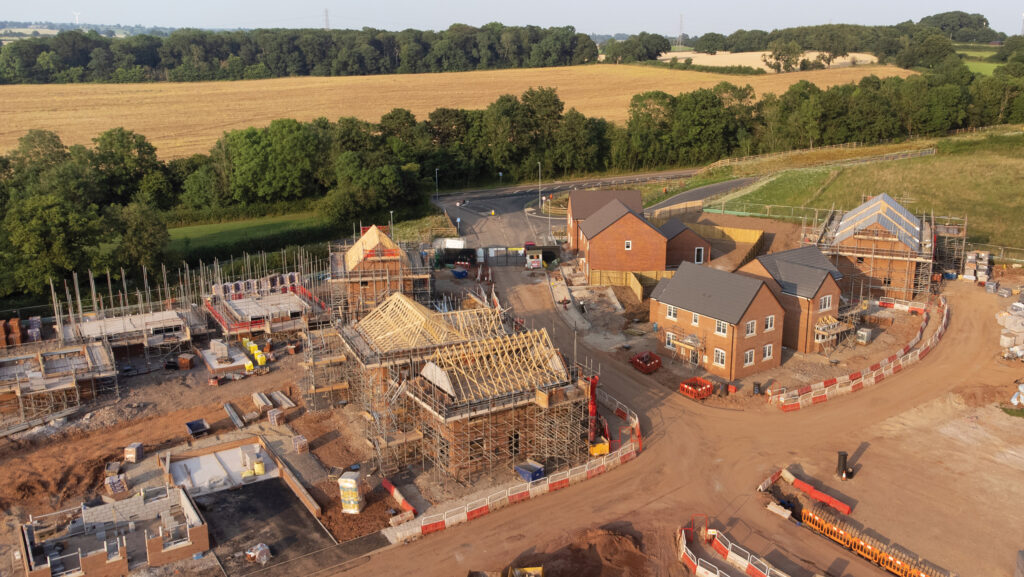How proposed planning reforms may affect farmland
 © Chunyip Wong/iStockphoto
© Chunyip Wong/iStockphoto Ministers have made a series of announcements on planning and released a consultation on revisions to the National Planning Policy Framework (NPPF).
This is the top-level planning policy document for England, which defines the approach that must be taken into account as a material consideration by local planning authorities.
See also: What’s new with Class Q permitted development rights
Hannah Moule, founder of the Rural Planning Co, says the government’s primary focus so far is on delivering new housing.
This reflects the Labour Party’s manifesto pledge to “get Britain building again”, and deliver 1.5m new homes over the five-year term of the parliament.
“While there is very little in the NPPF revisions specifically targeted at supporting rural economic development, a number of the planned reforms will open opportunities for some farmers and landowners,” says Hannah.
The key changes are:
Housing supply
The goal is to increase the number of new homes created in England each year to 370,000. This is a significant leap, as government statistics show only 212,570 new build homes were created in 2022-2023.
To achieve this, the government has promised to:
- Introduce a new revised standard for assessing housing need, which will be mandatory for local authorities to adopt
- Reinstate the requirement for local authorities to have a five-year housing land supply
- Identify “grey belt” land within the green belt, which can be brought forward into the planning system.
Hannah says the proposals will open up both short- and long-term opportunities for any farmers and landowners who are open to selling land for development, and who have land in the right places.
This might range from a small paddock in the village to a large strategic site.
“If an estate or farm has a potential site and the local authority, as a result of change in the calculation for housing need, no longer has an adequate five-year land supply, it is going to be a good time to see if it is a scheme that could be taken forward,” she adds.
Planners may have to grant permission on land which they previously have refused, and increase the volume of housing they allow if they are to meet the targets set.
“Development will still need to be a sustainable location, so it still needs to be adjacent to or near villages and towns,” says Hannah.

© Chris Hepburn/istockphoto
“We are not going to get into the realms of getting permission on blocks of land in the middle of nowhere, but whereas before, in a village they might have let 50 houses through, they might now be willing to let 150 through, potentially on multiple sites.”
Hannah acknowledges that the question of competing land uses is likely to be hotly debated, with many farmers worried about the potential loss of farmland for food production.
However, selling even a small site for development can bring a lot of money into a farming business.
Melanie Bingham-Wallis, planning director for Foxes Rural, agrees the proposals should open up fresh opportunities, particularly where councils are underperforming on their housing targets.
Where councils have underdelivered on housing delivery for the past three years, they are obliged to build in a 20% buffer on top of their calculations for land supply, otherwise only a 5% buffer is needed.
“Generally, we see the changes as very positive towards strategic development land,” says Melanie.
“There may be opportunities for small residential developments at settlement boundaries, where councils cannot demonstrate a five-year housing supply.
“Councils will then continue to require land to maintain this supply, designating more land parcels within their local plans to strategic development,” says Melanie.
What about food production?
A footnote added to the National Planning Policy Framework (NPPF) in 2023 said the availability of land for food should be adequately weighted in the planning process.
The current consultation suggests removing this.
The NFU claims this is “unproductive and a step backwards”, but the CLA argues agricultural land already has sufficient protection, and so this footnote is not required.
Grey belt
One of the most talked about aspects of the revisions to the NPPF is the idea of reclassifying some green belt land as grey belt, to bring more land suitable for development into the system.
According to the consultation, grey belt could be defined as:
- land which falls within the green belt but is either classed as previously developed land;
- or land which makes a limited contribution to the five purposes of the green belt.
Any green belt development would then be prioritised, with previously developed land being selected first, then grey belt land in sustainable locations, followed by other “sustainable locations” in the green belt.
Frank Smith, managing partner at Frank Smith & Co Solicitors, says this could mean land which has been developed but now lies abandoned or in disrepair.
This could be disused carparks and petrol stations, as well as land on the edge of existing urbanised areas or roads.
“It will be considered as a secondary option to development on brownfield sites – which are old industrial sites or already built-on land,” he adds.
Abel Bunu, principal planner with land agent Robinson & Hall, says grey belt status could offer some farmers an uplift in the value of parcels of land that they may have previously been unable to develop for housing.
“However, the more I read the definition, the more I do think it is open to a lot of subjectivity, and I hope we get greater clarity from the consultation,” he says.
Abel points out that the proposal is to identify grey belt land within the green belt – yet green belt only covers about 13% of England’s land area, with the majority of farmland falling outside of it.
“Focus appears to be on the green belt, but what happens to those farms outside of it which have potential for housing or commercial development? We need clarity on that,” he says.
The current definition of previously developed land is not specific to the green belt.
Under the existing NPPF definition of previously developed land or brownfield sites, a redundant farmyard would not fall into the definition of previously developed land.
This is because it specifically excludes land and buildings which are, or were, last used for agricultural or forestry purposes.
However, Abel says that regardless of his reservations about the grey land definition, he can see an opportunity for farmers to benefit from this proposal if the land and buildings make only a limited contribution to the green belt.
The government is also seeking views on whether it should expand the definition of previously developed land to include hardstanding and glasshouses.
Benchmark values for green belt land
Where land is released for “major development” in the green belt, it will be subject to a set of golden rules.
These include delivering 50% affordable homes, increasing access to green spaces and putting the necessary infrastructure in place, such as schools and GP surgeries.
The consultation also wants to see a national benchmark value set for green belt land to make developments viable and so able to meet these rules.
It says that these values should be fair and at a premium above existing use value.
Citing academic papers on the subject of benchmark land values and existing practice by local planning authorities, it indicates these in a range from three times to 40 times existing land use value.
It also indicates that it prefers something in the lower end of this range.
Where green belt land is not brought forward on a voluntary basis, compulsory purchase will be considered.
Observers point out that, as with similar existing powers, this will be a slow and expensive route and unlikely to achieve the housing targets set.
In relation to green belt land development, the consultation states:
“Our proposals do not remove the requirement for planning policies and decisions to recognise the benefits of the best and most versatile agricultural land, and, where significant development of agricultural land is demonstrated to be necessary, areas of poorer quality should be preferred.”

© Adobe Stock
Other key changes
The consultation also seeks views on revisions to the NPPF to increase support for renewable energy schemes.
In line with a commitment previously made by the Chancellor, it proposes that onshore wind projects larger than 100MW will come within the nationally significant infrastructure projects (NSIPs) regime.
It also suggests increasing the threshold at which solar projects are determined as NSIPs to 150MW.
The consultation period closes on 24 September 2024.
Permitted development reminder
The National Planning Policy Framework (NPPF) consultation follows an overhaul of permitted development rights in May 2024.
Farmers can benefit from an increase in floor area of agricultural buildings under Class A, and opportunities to gain commercial development were also increased.
“Finally, significant changes were made to the Class Q change of use from agricultural building to dwelling house legislation to allow a greater number of dwellings to be created, changes to the maximum floor area of each dwelling, allowance of extensions and most significantly, the clock [for eligibility] was reset to July 2023,” says Melanie Bingham-Wallis.
This means that a building constructed under full planning permission prior to 24 July 2023 may now be eligible for permitted development under Class Q. Previously, it must have been erected before March 2013, or 10 years before the date of application.
Hope value – risk or red herring?
Councils gained new powers earlier in 2024 to use compulsory purchase to acquire land without accounting for any hope value in the compensation payment to the landowner.
However, this applies only to land destined for social and affordable housing purposes, or for educational or health uses.
Frank Smith says it is a policy that seems to have been decided without consideration of the impact it might have on farmers.
“At the most basic level, any agricultural land that is bought under a compulsory purchase order and replaced with housing could further impact both the value of the rest of the farmland and the quality of the farming, due to the proximity of the farm to a new house settlement and loss of amenity due to development,” he says.
However, Abel Bunu says he sees no reason for farmers to panic that land is going to be compulsory purchased by councils to build affordable housing.
They will be aware that they would likely face a legal challenge from landowners, and the whole process could be “excruciatingly slow” and expensive.
“Realistically, I don’t think a lot of councils have enormous resources at their disposal to fight legal challenges – they don’t come cheap, and this could be counterproductive as land would not be released pending resolution of the challenge,” Abel says.
